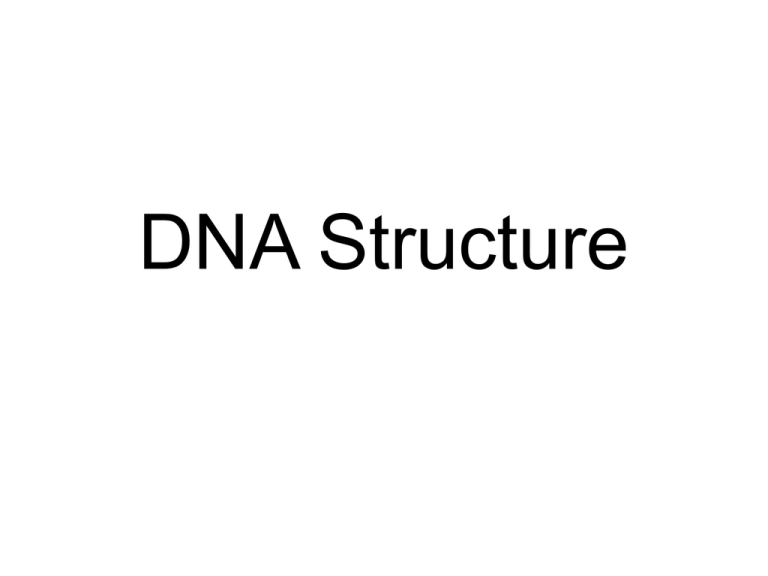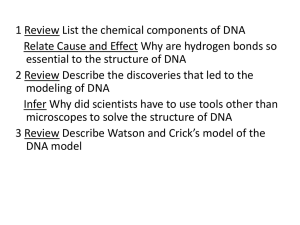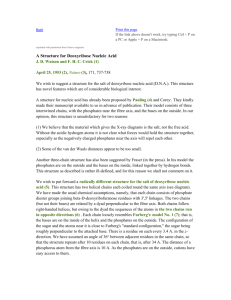DNA Structure
advertisement

DNA Structure • By the early 1900’s it was known that the chromosomes carry the genetic (hereditary) information • Chromosomes consist of DNA (deoxyribonucleic acid) I. Chemical Structure of DNA A. Nucleotide: 1. Thousands of repeating units that make up the DNA (DNA is a polymer) a) a phosphate group b) a deoxyribose molecule (5-carbon sugar) c) a nitrogenous base adenine, thymine, guanine, cytosine (There are four different types of nucleotides, depending on which of the four bases is present- A, T, C, or G) II. The Watson-Crick Model of the Structure of DNA DNA consists of two chains of nucleotides in a ladder-like structure which is twisted (Double Helix) James Watson & Francis Crick: • Used data of M.H.F. Wilkins and Rosalind Franklin, early 50’s • Wilkins and Franklin studied the structure of DNA crystals using X-rays. • The X pattern suggested the structure of DNA was a helix. Distance between the two “backbones” of DNA is constant along the length of the molecule • Used data of Erwin Chargaff, 1940’s and early 50's • Chargaff’s Rule: His data showed that in each species, the percent of A equals the percent of T, and the percent of G equals the percent of C. Watson and Crick (1953) Watson and Crick Model: A. The sides of the ladder are made up of alternating molecules of phosphate and deoxyribose B. The bases make up the rungs of the ladder C. The bases that make up the rungs of the ladder are attracted by a weak chemical bonds called hydrogen bonds Base Pairing Rule Adenine (A) pairs with Thymine (T) Guanine (G) pairs with Cytosine(C) Structure of DNA Animations • http://207.207.4.198/pub/flash/24/menu.swf http://www.pbs.org/wgbh/nova/genome/dna.html# Watson and Crick’s Double Helix Model explained: 1. How replication of DNA during mitosis produces exact copies for the daughter cells 2. How DNA acts as a code, specifying how proteins are made by the cell DNA Replication 1. The double-stranded DNA molecule separates or “unzips” along the weak hydrogen bonds between the base pairs 2. Free nucleotides that are present in the nucleus attach themselves by hydrogen bonds to the exposed bases (A-T, C-G) 3. Two identical strands form from each strand of DNA DNA Replication Animations http://www.lewport.wnyric.org/JWANAMAKER/animations/DNA%20Rep lication%20-%20long%20.html http://www.johnkyrk.com/DNAreplication.html • If the order of bases along one strand of DNA is AGGTTACTGCAC what is the order of bases on the complementary strand? TCCAATGACGTG How Does DNA Act As A Code? • The order of bases on the DNA strand instructs the ribosomes how to synthesize proteins • Gene: portion of DNA that codes for the production of a specific polypeptide •Polypeptide: building block of a protein In terms of decreasing size: Nucleus → Chromosome → Gene → DNA








